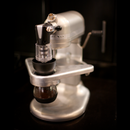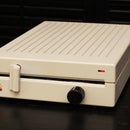Introduction: LED Hula Hoop
Some friends wanted a lighted hula hoop for burningman, and when they turned out to be about $200 each, I decided to make one. All the parts cost about $15 . . . total time to make the hoop was about 3 hours, but that included time for figuring things out. You could probably make one in less than 2 hours with this instructable and soldering skills . . .
Supplies:
12' - polyethylene tubing
1x tubing connector
6x LED's (or more if you like)
6x 69ohm resistors (calculate for your LED's)
6x LED holders
14'x2 copper wire
1x mini switch
1x AAA battery holder (2xbatteries, 3Volts)
assorted heat shrink
random paperclips
Step 1: Make Your Own Hoop
I can't claim credit for figuring out how to make the hoop itself. For that, see the JasonUnbound website http://www.jasonunbound.com/hoops.html. There, you'll find excellent instructions on making a great hoop! As for materials, I got my tubing and connector from US Plastics. I ended up getting a 100 foot roll of the 1" PE Flexible Pipe Not-NSF Listed 80 psi. Ended up making about 8 hoops with this, so on a per hoop basis, it's pretty cheap!
When making your hoop, there is one modification that needs to be done to the JasonUnbound version: File/cut off the ridges on one side of the tube connector. Cutting off most of the ridges as shown in the pic will allow you to take the tube apart when you need to replace the batteries, but still keep the tube together while hooping.
Step 2: Drill LED Holes
The hoop shown in the intro pictures had 3 LED's facing outwards, and 3 more LED's facing upwards to sorta "highlight" the hooper. Plan out your configuration and mark the hoop before drilling! I used a 1/4" drill bit, and drilled completely through the tube (you'll see why later).
Once you've drilled your holes, run a pair of copper wires through the length of your tube, leaving about 2 feet of extra length. I used a twisted pair scavenged from some old ethernet cables for this.
Step 3: Running Wires Through the Hoop
Make a handy wire pulling tool from a paperclip as shown in the pic. Now, you're ready to start wiring the LED's, starting from one end, working towards the end that has the 2 extra feet of wire.
With the wire pulling tool, fish around in the tube and pull the wiring through the first 1/4" hole. Since this is the end of the wire, pull it all the way out . . . an LED/resistor can be directly soldered to the end (next step). The rest of the wires should be pulled out only a few inches, enough for you to work with.
Once pulled out, cut the positive(+) wire, and stripped a section of the ground (-) wire. Strip both ends of the cut +wire and twist them back together. I didn't want to cut both wires, for fear that they'd accidentally pull back in the tube and cause me wire-fishing stress. The auto-wirestripper shown is one of the handiest tools I've ever bought!
Step 4: Soldering the LED's
Once you've got a wire pulled, solder a resistor (I used 69ohm) to the lead of your LED. Once again, another type of paperclip comes in handy.
Now slip a 1" length of heat shrink tubing over the twisted pair of +wires. The heat shrink should be able to fit over your resistor. I use a clip to hold the heat shrink in place, since it'll start shrinking if it gets too close when you're soldering the lead.
Next, solder the +wires to the other end of the resistor (see pics), and the -wire to the ground lead of the LED. I calculated my resistor value to be 75ohms, but the closest I could find was 69ohm. You may need a different value depanding on your LED's. Here's a quick LED resistor calculator that I used.
Clip the leads, and pull the heat shrink tubing over the entire +wire assembly (LED lead, resistor, +wire) as you don't want your +/- shorting together while hooping!
Step 5: Mount LED's
Next, mount the LED's in a 1/4" LED Holder . . . I got mine from Radio Shack, part #276-079. First , shove the LED assembly you just soldered, back into the 1/4" hole, just below the surface of the hole.
Then, snap the LED holder into the 1/4" hole you drilled. Now, while making sure the LED holder doesn't pop out, use a small rod (I used an old drill bit) to snap the LED into the LED holder from the back. This is where the hole through the entire hoop comes in handy! You should feel the LED snap into place.
Feel free to test your LED wiring at any time . . . you don't need to wire up the whole circuit before testing!
REPEAT STEPS 3-5 for all the LED's you plan on putting in
Step 6: Wire Switch and Batteries
Find a small switch, just about any switch will do . . . the crappier, the better actually, as long as it's tiny. In order to keep the hoop relatively flat all around, I cut off the switch "handle" until it was slightly more than flush with the main switch body. With a little bit of thumb friction, it's still easy to turn on/off.
For the switch hole, I drilled a 3/8" hole, then filed it square with a set of mini-files.
Next wire, the switch (don't forget heat shrink!) and the batteries. The batteries should be wired to original 2ft excess end, out the end of the hoop as shown.
As always, feel free to test as you go! Sucks to wast heat shrink!
Step 7: Finishing Up
Once you've turned everything on to make sure all LED's light up, it's time to button'er up! Slide the AAA battery holder in the end of the hoop, and connect the hoop together.
The switch should be snug in it's spot, but just to be sure, place some electrical tape around the tabs and hoop to keep the switch from flying out.
Happy Hooping!
Participated in the
The Instructables Book Contest













